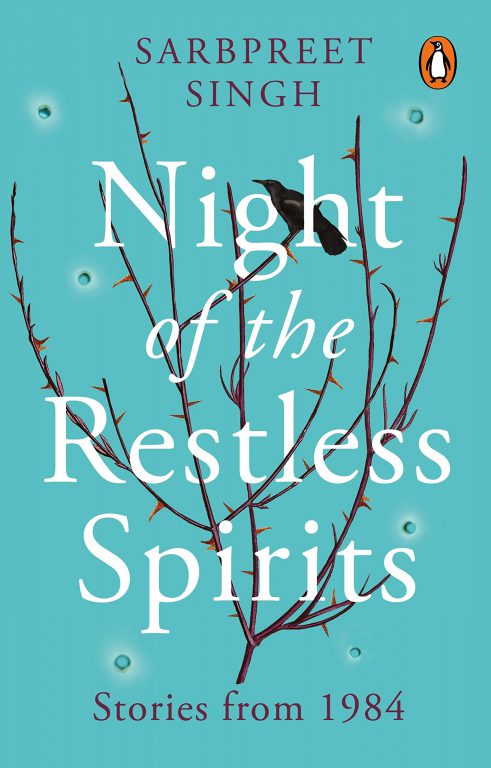

In this review, Shruti Devgan writes about how Sarbpreet Singh’s Night of the Restless Spirits explores the violence of the 1984 pogrom against the Sikh community by the Indian state. Devgan sheds light on how fiction becomes a tool of political critique when conversations are not only censored but manipulated to further stigmatize an oppressed minority.

In June 1984, following several tensions and under the pretext of apprehending “terrorist elements,” the Indian Army under State leadership invaded the Golden Temple, the theo-political center of Sikhs in the Northwest Indian state of Punjab, killing thousands of pilgrims. Shortly after this attack, Prime Minister Indira Gandhi was assassinated by her Sikh bodyguards on 31 October 1984. This precipitated the organized, State-backed massacre of Sikhs in Delhi and other parts of India in which more than 3,000 Sikhs died. In Punjab, the events of 1984 initiated at least a decade of extrajudicial killings, disappearances, atrocities and torture sanctioned by the State. 1984 became shorthand, symbolizing the violence of June and October-November, but also the tensions between the Sikh community and State, when the State assumed a Hindu identity, drawing a simplistic association between the majority Hindu community as the rightful proprietors of India.
1984 became a taboo subject for Sikhs in India as the State and mass media constructed a narrative to blame, shame and stigmatize the community. A militant movement for a separate Sikh state emerged as a counter-narrative. While this movement was powerful and deserves to be contextualized and understood in its own right, Sikh counter-narratives are more nuanced than only a territorial movement for self-determination. These complex counter-memories and re-presentations of the violence started becoming part of the public discourse in the early 2000s, when an intergenerational cohort of transnational Sikhs began to talk back to dominant representations of 1984. Memories of 1984 are evolving: digital media are changing ways in which those who were written about become authors while individuals and groups directly engage with media, interpret and construct events. Digital media are creating the conditions for Sikhs to elaborate a public and visible archive of a troubled past along with the recent emergence of artwork, film, non-fictional and fictional literature on 1984 as significant sites and modes of resistance.
Sarbpreet Singh’s Night of the Restless Spirits (2020) embodies and furthers this spirit of resistance. The publication of a book of stories on the 1984 anti-Sikh violence written by a Sikh-American writer constitutes in itself an act of subversion in the Indian context. Night of the Restless Spirits joins the ranks of other recent literature on 1984, including Roll of Honor, Helium and The Radiance of a Thousand Suns. While these books are catalogued under fiction, they are part of a genre that defies easy categorization into fact and fiction. While the boundaries between fiction and reality are blurred in any piece of literature, those who know about the conflict in Punjab and the events of 1984 understand that stories like Night of the Restless Spirits are more testimonies than tales of a difficult past.
For a younger generation oblivious of this gory chapter in Sikh and Indian history, yet living in a Hindutva State where minorities are routinely demonized and murdered, this book provides a genealogy of such violence. There are parallels in how the majoritarian Hindu discourse renders bodies of certain minority groups contaminated, disposable and sometimes not even worthy of death – such as the liminal death of the disappeared, who are suspended between life and death. Nevertheless, there is a permanence, decisiveness and durability to how Muslims in India are constructed as the other, while Sikh othering has a sporadic, ambivalent and ephemeral quality to it. Singh’s book comes at a time when the narrative of Sikhs as the enemy within has resurfaced in the public discourse. The ongoing farmers’ protests at the border of Delhi, where Sikh farmers have been at the helm of the movement, have disinterred the narrative and imagery of the Sikh as Khalistani, or separatist and anti-national.
The events of 1984 were part of a larger story of violence against Sikhs. 1984 was both preceded and followed by a complex and violent entanglement between the Indian State and the Sikh community. Singh alludes to this broader context in some stories, but his focus is on the Indian government-led attack on the Golden Temple in June and the November massacre of Sikhs in Delhi and other parts of India.
The opening story of Singh’s book, Phaji, starts with a nameless narrator — a popular and good-looking Kashmiri high school boy — recalling the events of 1984. He starts the story by describing the pecking order at the elite Delhi school he attended. He narrates with underlying tones of sexism and condescension, referring to the female students as “Skirts” and “Salwars,” where the western attire was code for a higher rank in the school hierarchy. Soon, however, he finds himself drawn towards a Sikh girl at school, Sharan, a “Salwar” and an unlikely romantic interest. As the narrator is drawn into Sharan’s world, he develops an especially close relationship with her elder brother, Phaji. Even though the summer of 1984 only arrives halfway into the story, an ominous feeling envelopes the reader evoking fear for the protagonists, especially Phaji, from the very first moment he is introduced. What unfolds is that these seemingly fictional characters live the horrors of the all-too real events of the November violence.
The entanglement of fact and fiction mean that Singh’s imagination and creativity are deeply informed by what was later uncovered and documented by activists, lawyers, civil rights organizations, scholars and journalists. For example, while in most official and mass media accounts the November violence is represented as confined to Delhi, evidence suggests that the bloodshed and murder of Sikhs was more widespread. These stories outside of Delhi are only just beginning to emerge and even becoming part of popular culture. Similarly, most accounts of 1984 have not considered the caste and class dimensions underlying the losses. In Singh’s short story The Curfew, he addresses these omissions. The narrator, an Arya Samajist Hindu man – an interesting choice given the historical tensions between the Arya Samaj and Sikhs – from a humble background who nevertheless manages to secure the elusive position of a civil servant, writes in the first person to tell the story of 1984 as it unfolds in the small city of Hoshangabad in Madhya Pradesh. Singh identifies the splits within the Sikh community when he writes about Sikligar Sikhs, segregated from the “rest of city’s Sikhs” because of their “low caste status” (p. 91). As violence breaks out in this marginalized neighborhood, the narrator and his fellow officers including the Superintendent of Police stand vigil at the gurdwara. The narrator describes the tranquil scene and people at the gurdwara:
A Sikh man in his late thirties, wearing a blue turban and startingly white, crisply ironed kurta-pyjama (sic), was seated on the beautifully canopied dais, chanting a prayer, with his eyes closed […] A teenaged girl, who I remember was exceptionally beautiful, stood behind him in a simple salwar-kameez, gently playing the traditional whisk you see at every gurdwara over the scripture, as her father continued to chant […]. (p. 97)
Singh recounts the State’s complicity in the violence as the plot progresses: the narrator discovers that the local state legislator had been seen stepping out of a white Ambassador car to meet with the organizer of the violence, a schoolmaster in the area. This evokes real events, when mobs were not just given free license to kill Sikhs in 1984, but even Police officials and political leaders joined in the orgy of destruction. In The Curfew, Singh writes of the disconcerting consequences of such complicity and inaction and takes us back to the gurdwara that the narrator finds “charred […t]he silk canopies above the raised dais in tatters, and the book that had rested in its aegis, swathed in fine silks […] half burnt, ripped pages scattered on and around the dais,” and the girl was “nowhere to be found” (p. 100). Eventually, the narrator defies official orders and jeopardizes his career by calling in the Army. Inspired by the politically motivated failure of the ten inquiry commissions that followed the 1984 violence, Singh’s plot includes an inquiry that finds the narrator guilty and condemns the calling of the Army. Singh rehearses the non-fictional official narrative when he writes that the inquiry deemed the violence “as a spontaneous expression of anguish and rage directed against the Sikh community by individuals, distraught at the murder of the beloved prime minister. There was absolutely no evidence […] that there ha[d] been an organized effort to retaliate against the [Sikligar] Sikhs […].” (p. 115)
The General is one of the more autobiographical stories of the book, given that Singh is Sikh-American himself and has collaborated with his daughter on a play about 1984 based on a poem he wrote, which is also part of this book. In the story Meg, a White female protagonist married to a Sikh man named Raja, becomes embroiled in the diasporic mobilization and the movement for an independent Khalistan following the attacks of 1984. Combining fact and fiction, memory and history, Singh gives an account of the Madison Square Garden rally in New York that led to the formation of the World Sikh Congress, and which urged Sikhs in the Indian government to “dissociate themselves from the regime,” demanded the restoration of civil liberties in Punjab and lifting press restrictions (p. 61). Raja becomes involved in the movement and, after he “disappears” on a trip to India undertaken on behalf of the Khalistan movement, Meg is filled with pain and rage and does everything to distance herself from the events, the movement and the Sikh faith itself. Yet, when her daughter, Liv, shares her interest in working with Ensaaf, a real-life organization focused on documenting disappearances in Punjab, Meg is forced to face her ghosts. Meg discovers on Liv’s desk Reduced to Ashes: Insurgency and Human Rights in Punjab, a book about human rights activist Jaswant Singh Khalra, who documented disappeared Sikhs until he was disappeared himself. Upon reading the various case histories, some of which Singh reproduces in this story (p. 78), Meg notes: “For the first time in nineteen years, I felt something other than anger. I was not alone. Thousands of miles away, there were many other women who, perhaps like me, were waiting like I had been” (p. 78). By becoming conscious of her hauntings and making connections with other women like her, Meg is able to retrace her steps back to Sikhi. As Singh wraps up the story, he delivers a last blow by uncovering the Indian State’s betrayal of the Sikh community and revealing a secret about the revered Army general whose arrival on the scene had led to Raja’s liminal death.
In the title story, Night of the Restless Spirits, Singh provides a poignant, lyrical, even poetic account of Baba Fateh Singh, an old Sikh man in his last throes. The author conjures historical figures and ancestors from the Sikh past, the “tormented lost souls of Punjab,” (p. 127) who return “each time tyranny returns and innocents are butchered” (p. 127). In writing this haunting story of restless spirits congregating to prevent another catastrophe, Singh is evoking the repeated loss and trauma that the Sikh community has endured across precolonial, colonial and postcolonial time and space: 1947 and 1984 in India, post 9/11 attacks across the US, the gurdwara massacre in Wisconsin and the FedEx shooting in Indiana.
Perhaps the biggest strength of the book is the deftness with which Singh braids history and memory, reality and fantasy. Yet, one of the limitations of the book is also rooted in this skillful amalgamation of fact and fiction. For instance, one of the stories, The Court Martial, has Singh comparing the British with the Indian Army, but in doing so he valorizes the former, and even betrays a kind of nostalgia for the Empire (p. 142). In fact, the British invented Sikhs along with groups such as Gurkhas as martial races, ascribing them (especially men) with inherent martial skills. The British Army conjured this racial and gendered essentialized category as an “artificial strategy of rule during a period of imperial anxiety” and garner “unquestioned loyalty” from its subjects. Singh is not an academic, his book is not intended for a scholarly audience and neither does this claim find much space in the book. For all these reasons, reinforcing the martial race stereotype and elevating the British colonial rule can be dismissed as a minor omission. But the book’s very strength as a documentary and testimony, makes this an important enough concern. The other weakness of the book is also the flipside of its very strength as documentation. Some stories or parts of some stories read like a report on 1984, feeding every detail and nuance to the reader and leaving little to the imagination.
These limitations notwithstanding, Night of the Restless Spirits is an evocative, poignant, powerful and well-researched book that breaks new ground by telling the untold stories of 1984 and by blurring the lines between history and memory, rationality and affect, past and present.





